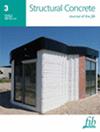混合纤维钢纤维加固混凝土梁中的纤维取向和取向系数:重要综述
IF 3.3
3区 工程技术
Q2 CONSTRUCTION & BUILDING TECHNOLOGY
引用次数: 0
摘要
纤维取向对纤维增强混凝土(FRC)结构件的设计至关重要,因为它对这种材料的开裂后性能有显著影响。因此,结构规范引入了取向系数,目的是将结构元件的实际机械性能与根据标准梁确定的机械性能联系起来。虽然在设计规范中考虑纤维取向的必要性已被普遍接受,但取向系数仍是基于有限的研究成果,因此需要更好地确定纤维取向,以改进现行标准,支持 FRC 构件的设计过程。在这项研究中,采用宏观和微观纤维混合系统的钢纤维增强混凝土(SFRC)被引导成多种纤维取向,并浇注到标准梁中。除了测量这些 SFRC 梁的力学性能外,还采用了三种不同的纤维取向评估方法,即电磁感应法、图像分析法和微计算机断层扫描法。通过比较不同方法的结果,可以详细了解每种方法的准确性和适用性,并考虑到结构层面的相应适用范围。最后,对文献中最常见的二维和三维取向参数进行了严格审查,并对方程进行了调整,以考虑到纤维的混合系统。本文章由计算机程序翻译,如有差异,请以英文原文为准。
Fiber orientation and orientation factors in steel fiber‐reinforced concrete beams with hybrid fibers: A critical review
Fiber orientation is of paramount importance for the design of fiber‐reinforced concrete (FRC) structural elements, because it markedly influences the postcracking properties of such material. For this reason, structural codes introduce orientation factors which aim to correlate the real mechanical properties of the structural element with the ones determined from standard beams. Although the need of considering fiber orientation in design codes is commonly accepted, the orientation factors are still based on a limited number of research studies, raising the need to better determine fiber orientation to improve the current standards and support the design process of FRC elements. In this research, a steel fiber‐reinforced concrete (SFRC) with a hybrid system of macro and microfibers is steered into a broad range of fiber orientations and cast into standard beams. Besides measuring the mechanical performance of these SFRC beams, three different methods for assessing fiber orientation are employed, namely electromagnetic induction, image analysis, and micro‐computed tomography. The comparison between the outcomes of the different methods provides detailed information about the accuracy and suitability of each method, considering the corresponding domain of applicability at structural level. Finally, a critical review of the most common 2D and 3D orientation parameters found in literature is performed, and the equations are adapted to account for the hybrid system of fibers.
求助全文
通过发布文献求助,成功后即可免费获取论文全文。
去求助
来源期刊

Structural Concrete
CONSTRUCTION & BUILDING TECHNOLOGY-ENGINEERING, CIVIL
CiteScore
5.60
自引率
15.60%
发文量
284
审稿时长
3 months
期刊介绍:
Structural Concrete, the official journal of the fib, provides conceptual and procedural guidance in the field of concrete construction, and features peer-reviewed papers, keynote research and industry news covering all aspects of the design, construction, performance in service and demolition of concrete structures.
Main topics:
design, construction, performance in service, conservation (assessment, maintenance, strengthening) and demolition of concrete structures
research about the behaviour of concrete structures
development of design methods
fib Model Code
sustainability of concrete structures.
 求助内容:
求助内容: 应助结果提醒方式:
应助结果提醒方式:


